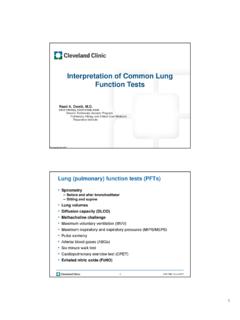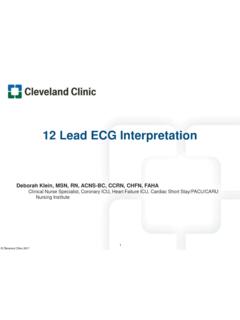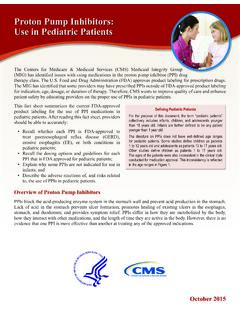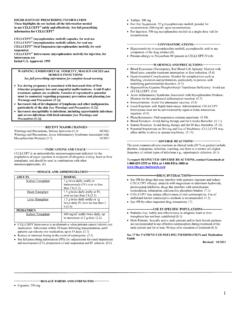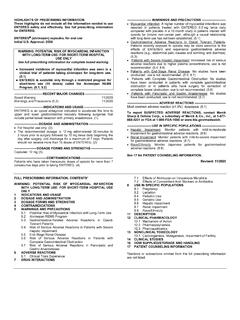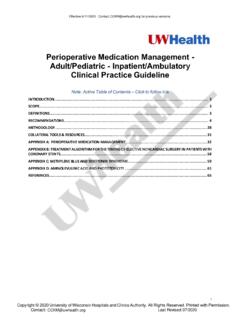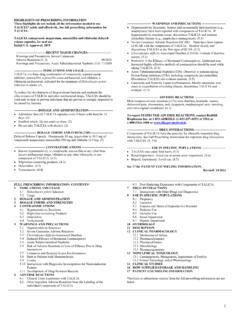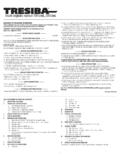Transcription of Dose Conversion Chart for PPIs for IV Administration
1 CYP450 2D6). This is because codeine is a prodrug and requires Conversion to morphine via the CYP450 2D6 to produce a Dose Conversion Chart for PPIs for IV Administration : clinical effect. On the other hand, UMs may experience enhanced analgesia from codeine as well as more adverse effects. Not only can genetic variations affect Phase I metabolism, but they can also affect Phase II metabolism or conjugation reac- Lansoprazole IV to Esomeprazole IV. tions. patients who are slow acetylators are at an increased risk for peripheral neuropathy from isoniazid or at an increased risk Formulary Restriction of developing systemic lupus erythematosus (SLE) from procainamide, since both of these drugs need to be acetylated for me- Regardless of the route of Administration ( , continuous infusion [CI], IV Piggyback [IVPB], or IV Push), tabolism. However, patients who are fast acetylators may not respond to these medications because of increased metabolism.
2 IV PPI use is restricted to Staff Physicians from the Department of Gastroenterology for patients with a con- firmed, acute GI bleed ( , EGD/endoscopy) to prevent re-bleeding. Genetic polymorphisms can also affect drug receptors and signal transductions which have the potential to alter the effect of For initiation of an IV PPI, patients must be in an ICU setting, but therapy may be continued on all drugs on the body. Most of these pharmacodynamic interactions are not clearly understood, however, an example is the over- nursing units. expression of the HER2/neu oncogene in some breast cancers. The treatment of this oncogene appears to be most beneficial Based on available data in the literature, for prevention of re-bleeding in patients with an acute GI bleed, an with trastuzumab (Herceptin ), which specifically targets the gene overexpression.
3 IV bolus of a PPI followed by a CI should be used. IV PPI CI should be used for no longer than 72 hours ( , patients need to be converted to PO or NG admini- It is important to be able to detect genetic variations in patients . Presently, there is one genotyping test approved by the Food stration as soon as possible using esomeprazole 40 mg PO or lansoprazole SoluTab 30 mg NG once daily). and Drug Administration (FDA). The Roche AmpliChip Cytochrome P450 test determines a patient's ability to metabolize If patients continue to be NPO after 72 hours, then the esomeprazole CI should be converted to drugs through CYP450 2D6 and 2C19 isoenzymes. This test is done at a health care facility or a physician office. The Roche esomeprazole 40 mg IV Push once daily. Esomeprazole IV Push should only be dispensed for patients initi- AmpliChip Cytochrome P450 test costs approximately $520 and requires an average of 8 hours to determine the results.
4 The ated on esomeprazole CI in the ICU who are unable to be converted to esomeprazole PO or lansoprazole Solu- device to interpret the results costs over $250,000. It is important to note that this test only evaluates two CYP450 isoenzymes Tab NG Administration . and does not explain in depth the specific variations. Another recent advancement in pharmacogenomics is the approval of thio- Esomeprazole 40 mg IV = Esomeprazole 40 mg PO or Lansoprazole SoluTab 30 mg NG. purine methyltransferase (TPMT) testing for gene variation when administering 6-mercaptopurine (6-MP). Genotyping of TPMT may help to identify patients at risk for life-threatening bone marrow suppression. Therapeutic Interchange Dose Conversion : Lansoprazole (Prevacid ) 60 mg IV bolus, followed by 6 mg/hr infusion for up to 72 hours =. In summary, it is anticipated that specific pharmacogenomic tests will be used as a primary measure to determine the correct Esomeprazole (Nexium ) 80 mg IV bolus, followed by 8 mg/hr infusion for up to 72 hours drug and dose for a patient, especially for medications with a narrow therapeutic index.
5 The current approach for prescribing medications to the average patient will eventually move to more individualized therapy, and the end result is expected to be an improvement in drug efficacy and safety. Proton Pump inhibitors (PPIs) Therapeutic Interchange Dose Conversion Chart for PPIs for Oral Suspension or NG Administration : Rationale: TAP Pharmaceuticals no longer has a contract for lansoprazole capsules ( , significant price increase), therefore, Esomeprazole Capsules to Lansoprazole SoluTabs . the Cleveland Clinic Hospitals have made a change in the automatic therapeutic interchange for the proton pump inhibitors (PPIs). As of January 3, 2006, the PPI on the Cleveland Clinic Formulary for adult patients who do not require a suspension is Esomeprazole (Nexium ) 40 mg once daily = Lansoprazole (Prevacid SoluTab ) 30 mg once daily esomeprazole (Nexium ).
6 All new medication orders for PPIs ( , lansoprazole, omeprazole, pantoprazole, and rabeprazole) Esomeprazole (Nexium ) 40 mg twice daily = Lansoprazole (Prevacid SoluTab ) 30 mg twice daily for oral (PO) and intravenous (IV) Administration , will be automatically converted to esomeprazole. The PPI on the Formulary Esomeprazole (Nexium ) 20 mg once daily = Lansoprazole (Prevacid SoluTab ) 15 mg once daily for adult patients who require an oral suspension or nasogastric (NG) Administration is lansoprazole orally-disintegrating tab- lets (Prevacid SoluTab ). The reason for this is because 1) there is no recipe to compound an esomeprazole suspension, and 2) it is difficult to ensure when esomeprazole capsules are opened and placed in water that all of the pellets inside are adminis- Prevacid SoluTabs (orally-disintegrating tablets): tered to the patient ( , not sticking to the medicine cup or inside an oral syringe).
7 Prevacid SoluTabsTM should not be swallowed whole or chewed. Place tablet on tongue; allow to dissolve (with or without water) until particles can be swallowed. Dose Conversion Chart for PPIs for Oral Administration : Lansoprazole to Esomeprazole Prevacid SoluTabsTM may also be administered via an oral syringe (for NG Administration ): Lansoprazole (Prevacid ) 30 mg once daily = Esomeprazole (Nexium ) 40 mg once daily Place the 15 mg SoluTab in a 5 mL oral syringe and draw up 4 mL water, or Lansoprazole (Prevacid ) 30 mg twice daily = Esomeprazole (Nexium ) 40 mg twice daily Place the 30 mg SoluTab in a 10 mL oral syringe and draw up 10 mL water Lansoprazole (Prevacid ) 15 mg once daily = Esomeprazole (Nexium ) 20 mg once daily Shake gently to allow for quick dispersal of SoluTab . After the SoluTab has dispersed, administer to the patient within 15 minutes Omeprazole to Esomeprazole Refill the syringe with water (2 mL for the 15 mg tablet; 4 mL for the 30 mg tablet), shake gently, and then ad- minister any remaining contents.
8 Omeprazole (Prilosec ) 40 mg once daily = Esomeprazole (Nexium ) 40 mg once daily Note: For the Children's Hospital, pediatric patients requiring a PPI may receive esomeprazole capsules, lansopra- Pantoprazole to Esomeprazole zole SoluTabs , or lansoprazole IV (IV formulation is restricted). Pantoprazole (Protonix ) 40 mg once daily = Esomeprazole (Nexium ) 40 mg once daily Rabeprazole to Esomeprazole Rabeprazole (Aciphex ) 20 mg once daily = Esomeprazole (Nexium ) 40 mg once daily CYP450 2D6). This is because codeine is a prodrug and requires Conversion to morphine via the CYP450 2D6 to produce a Dose Conversion Chart for PPIs for IV Administration : clinical effect. On the other hand, UMs may experience enhanced analgesia from codeine as well as more adverse effects. Not only can genetic variations affect Phase I metabolism, but they can also affect Phase II metabolism or conjugation reac- Lansoprazole IV to Esomeprazole IV.
9 Tions. patients who are slow acetylators are at an increased risk for peripheral neuropathy from isoniazid or at an increased risk Formulary Restriction of developing systemic lupus erythematosus (SLE) from procainamide, since both of these drugs need to be acetylated for me- Regardless of the route of Administration ( , continuous infusion [CI], IV Piggyback [IVPB], or IV Push), tabolism. However, patients who are fast acetylators may not respond to these medications because of increased metabolism. IV PPI use is restricted to Staff Physicians from the Department of Gastroenterology for patients with a con- firmed, acute GI bleed ( , EGD/endoscopy) to prevent re-bleeding. Genetic polymorphisms can also affect drug receptors and signal transductions which have the potential to alter the effect of For initiation of an IV PPI, patients must be in an ICU setting, but therapy may be continued on all drugs on the body.
10 Most of these pharmacodynamic interactions are not clearly understood, however, an example is the over- nursing units. expression of the HER2/neu oncogene in some breast cancers. The treatment of this oncogene appears to be most beneficial Based on available data in the literature, for prevention of re-bleeding in patients with an acute GI bleed, an with trastuzumab (Herceptin ), which specifically targets the gene overexpression. IV bolus of a PPI followed by a CI should be used. IV PPI CI should be used for no longer than 72 hours ( , patients need to be converted to PO or NG admini- It is important to be able to detect genetic variations in patients . Presently, there is one genotyping test approved by the Food stration as soon as possible using esomeprazole 40 mg PO or lansoprazole SoluTab 30 mg NG once daily). and Drug Administration (FDA).
